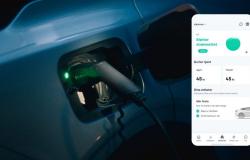PLUS:
Comfort, space.
MINUS:
Price, range, not 4WD.
CANNES (Engine): EQV came on the market late in 2020, now it’s here with a comfort and design update alongside the diesel or petrol-powered V-Class.
Mercedes-Benz has made a priority with these models – and flashed its premium position in this family transport segment.
And to make it clear:
They hijack that space easily, without anyone above or next to them.
For all we know, there can be good shop in the production of cars like this to transport more or less VIP-sized luxuriously from A to B.
Mercedes-Benz EQV 300
- Price: NOK 1,120,975 (6-seater), equipment level Avantgarde.
- Battery (gross)/engine/drivetrain: 90 kWt/150 kW/204 hp/365 Nm/one-stage automatic, front-wheel drive.
- Range/consumption (WLTP): 344–365 km, 27.1–28.8 kWh/100 km.
- Charging time: 40 min. 10–80 percent, maximum power 110 kW.
- Length/height/width/wheelbase (mm): 5140/1900/1928/3200.
- Weight/payload: 2811kg/689kg. Max roof load: 150 kg.
- Trunk: 1030 liters (4630 liters without seats).
- Wheel dimension: 17-, 18- or 19-inch.
- Competitors: Volkswagen ID. Buzz, Voyah Dream, Citroën E-SpaceTourer, Opel Zafira Electric, Peugeot E-Traveller, Toyota Proace Verso.
Perhaps even for sale in Norway, where 102 V-class and 466 EQVs have been registered as new cars since 1 January 2020.
The outdoor family?
In the marketing of the upgraded versions, Mercedes not only emphasizes the models’ general premium emphasis on comfort and functionality. They also talk about the cars’ attractiveness for large families and outdoor enthusiasts.
Does it also apply to Norway? Well…
Or, to be hero honest: no.
Here are the latest news we’ve tested:
More expensive and…
The way our new car market has developed, electric EQVs will be the obvious first choice between these two, as taxes make the V-Class almost 30 percent more expensive.
V-class starts in Norway at NOK 1,434,892, EQV at NOK 1,120,975.
But if it was difficult to understand which Norwegian buyers this car should attract in 2020, it is no easier in 2024:
-
Today’s entry price on the EQV is almost 35 per cent higher than it was when the car came on the market, helped by both general price growth and new tax rates.
-
The model has received one competitor with character and appeal in the form of the Volkswagen ID. Buzz, which has quickly hijacked the popular part of this market. To the extent that range is a factor, the price of a WLTP kilometer starts with ID. Buzz at NOK 1,489. In this EQV version, we are talking NOK 3,071 for the same thing.
-
And the car’s power and range is just as limited as it was back in 2020. Around 350 km in perfect conditions means a charging break if you’re loading up for a winter mountain trip, even if you choose a route uphill that doesn’t require four-wheel drive. It does not charge very quickly – from 10 to 80 percent in 40 minutes.
Famous people about the joys and sorrows of car ownership:
New platform
In short, this is still a car with much of the capacity level we remember from the first generation of electric cars that swept into the Norwegian market.
The second generation of EQV is coming. But in 2026 at the earliest.
Mercedes has been clear in its communication that it is preparing a completely new standard with the second generation of its electric family haulers, constructed on a platform with the sonorous name VAN.EA (VAN for truck, EA for “electric architecture”). The first models will arrive in 2026.
In short, this basic construction has three modules, one for each of the axles and a scalable middle module that allows for variation in battery size.
Are there any reasons not to wait?
Upgraded
EQV has received a solid interior upgrade in the form of a significantly airier, contemporary driving environment, with two integrated screens of 12.9 inches each behind the steering wheel and above the center console.
The screens are complemented by two horizontal air ducts and a basic selection of buttons for all climate control, and the traditional Mercedes multifunction control placed high between the seats. The overview is impeccable, the seat comfort first-class.
The car has regenerative brakingand the braking force can be regulated with the levers on the steering wheel, so that one-pedal driving is experienced as particularly comfortable.
On dry, French roads, the road noise was less annoying than in the previous version of the car we drove on Norwegian surfaces, but this was not measured during our test drive.
 ROM MED UTSIKT: Mercedes har plukket med det beste av ny design fra de senere EQ-modellene inn i et veldig oversiktelig og funksjonelt førermiljø." alt="" />
ROM MED UTSIKT: Mercedes har plukket med det beste av ny design fra de senere EQ-modellene inn i et veldig oversiktelig og funksjonelt førermiljø." alt="" /> SOM EN KONGE: Skaff deg noen glass med magnet nederst i stetten, så kan du la passasjerene sette glass med leskedrikk på platen på armlenet i midten – og det blir stående. Det er ikke veldig mange steder du sitter behageligere som passasjer i en firhjuling." alt="" />
SOM EN KONGE: Skaff deg noen glass med magnet nederst i stetten, så kan du la passasjerene sette glass med leskedrikk på platen på armlenet i midten – og det blir stående. Det er ikke veldig mange steder du sitter behageligere som passasjer i en firhjuling." alt="" />High comfort
Generally is the comfort improved with functionality that is often repeated among today’s new cars, not only with insulation that helps the sound image, but also such things as keyless start, wireless charging of mobile phones, and rich options in interior lighting.
The current EQV model for the Norwegian market primarily comes with a 6-seater configurationbut during the test drive Mercedes also presented 7- and 8-seater variants, as well as a 4-seater “premium-plus-plus” version of the V-Class with room for a sports shop in the back.
Even a standard 6-seater has 1030 liters of luggage space, if you remove the seats, you can fill over 4630 liters of luggage if you need to.
EQV can be preheated, both engine, compartment and seats, via the app.
Achilles heel
But the new car has the same Achilles’ heel as the old one, because it costs energy to move vehicles with a match weight of over 2.8 tonnes:
A 90 kWt battery (lithium-ion from CATL) with WLTP-measured consumption in the range between 28.8 and 27.1 kWt/100 km and ditto range between 344 and 365 km, depending on wheel size and equipment.
We had consumption in the upper part of the interval on a combination of winding country roads with alternating 50 and 80 zones, plus city driving in and outside Cannes, in Norwegian summer temperatures.
Under Norwegian conditions, there will be no WLTP surprises on the upper side of the estimate.
Limited power
The engine has an output of 204 kW/150 hp, it comes with four possible driving modes that vary to varying degrees regarding the modest range the car has.
Without offending anyone, we just have to admit that we have experienced more violent transformations when changing modes from Comfort to Sport, than in EQV.
For the cars on the VAN.EA platform, Mercedes has predicted a range of close to 480 km. Then we are talking about family freight, which can be sufficient for Norwegian conditions and consumption patterns.
Until then, this remains a car to enjoy primarily for those who need to be transported efficiently and comfortably between airports, hotels and congresses.
PS: Note that the weight of 2,811 kilograms + the payload of 689 kilograms = exactly 3,500 kilograms.
 SHOWETS STJERNE: Exclusive-versjonen av nye V-klasse har den legendariske stjernen over grillen." alt="" />
SHOWETS STJERNE: Exclusive-versjonen av nye V-klasse har den legendariske stjernen over grillen." alt="" /> TO BRØDRE: V-klasse til venstre, EQV til høyre." alt="" />
TO BRØDRE: V-klasse til venstre, EQV til høyre." alt="" />
Read all of Motor’s car tests:
Tags: Engine tested MercedesBenz EQV
-










